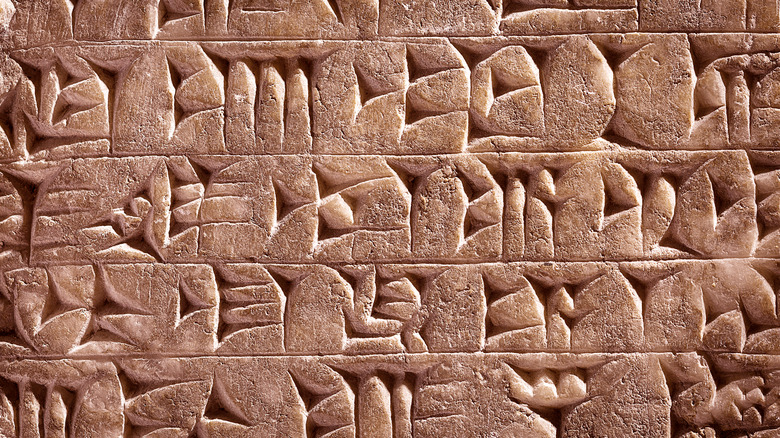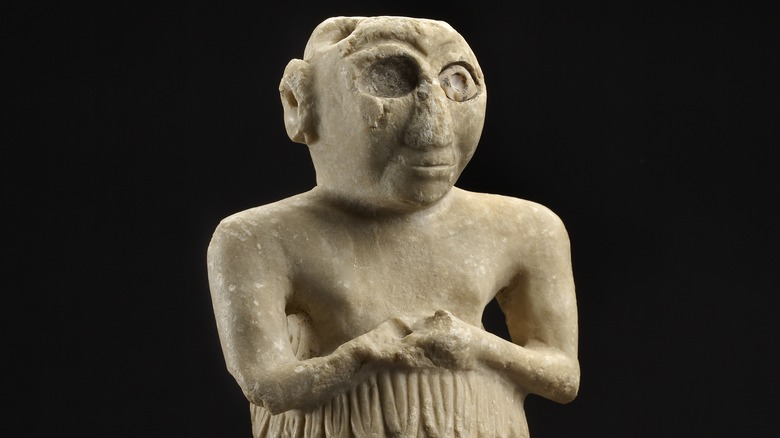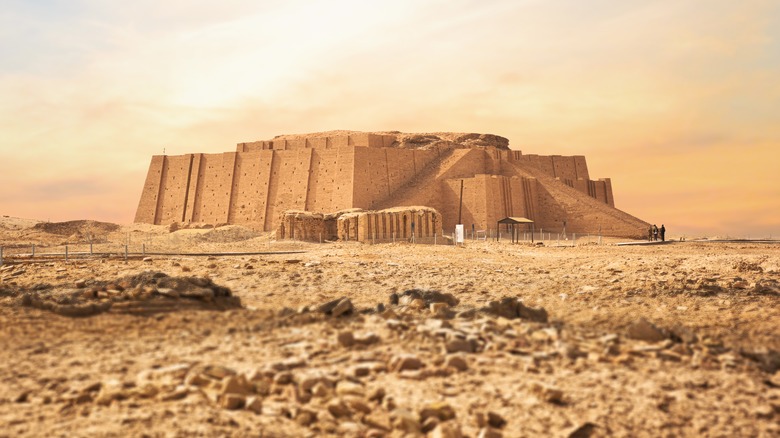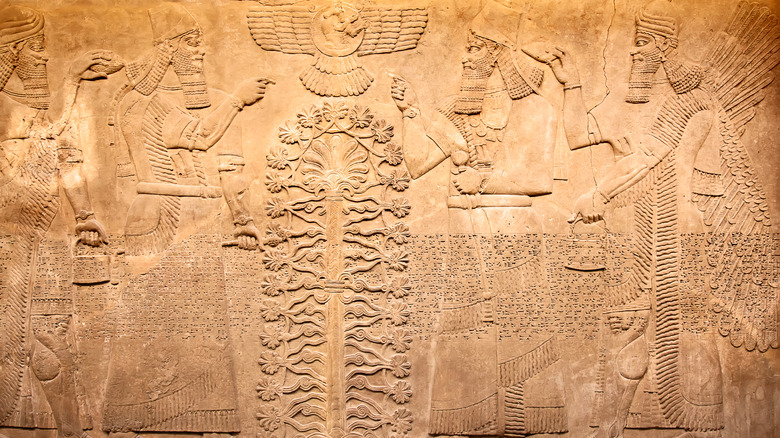What Is The Oldest Religious Holy Text On The Earth?
Religion has been a fundamental part of human civilization for what seems like time immemorial. For thousands of years, people have tried to make sense of this mysterious universe through stories of divine beings, monsters, and other supernatural creatures. Even in modern times, 84% of people worldwide view themselves as religious, belonging to a wide variety of different groups and organizations, some of which are thousands of years old (via Visual Capitalist).
Though not all religious or spiritual communities have kept written holy scriptures, making it impossible to know what the world's first religion was, historians and archaeologists have collected a fair amount of old manuscripts, providing keen insight into how ancient humans practiced religion. So, what is the oldest religious holy text experts have uncovered? Well, it doesn't come from Hinduism, Judaism, or any of the other major religious denominations today (per the Abrahamic Study Hall). Rather it comes from a time long before ours, found in an ancient city more than 4,000 years old in modern-day Iraq (via Ancient Origins).
The Kesh Temple Hymn
The text is known as the Kesh Temple Hymn, and it dates back to roughly 2600 B.C., found in what would be Sumer, one of the world's oldest civilizations (via Ancient Origins). This ancient empire began building religious buildings around 5200 BC, dating more than 7000 years ago, states History. The Sumerians are also credited with creating the oldest known written language, as well as pioneering technologies like crop irrigation, farming, and even advancing certain medicinal practices (via History).
The Kesh Temple Hymn was found in the Sumerian city Tell Abu Salabikh, written in cuneiform, a form of writing that describes events through different pictures on clay tablets. The text was 134 lines long, divided into eight different sections, portraying the city of Kesh as a righteous city that was near Ekur, the supposed place where the Sumerian gods gathered together (via Ancient Origins).
Sumerian religion
The Sumerians were polytheistic and believed that at one point, the world had been nothing more than the ocean, known as Nammu. Eventually, Nammu gave birth to the gods An and Ki, the former being the god of the sky and the latter the god of the earth, according to Study.com. Eventually, these divine beings procreated and gave birth to other gods, such as Enlil, the chief god of the Sumerian pantheon that controlled storms (via CK-12).
Sumerians thought that the gods were much like us and were swayed heavily by emotions. Therefore, it was of the utmost importance to keep them in a happy state of mind, or else they would curse the Sumerians with all sorts of natural disasters such as floods, storms, droughts, famine, disease, or some other catastrophe that was uncontrollable. As a result, priests were very respected in this society, and it was believed that they communicated directly with the gods.
Gods amongst people
Though no one knows who actually wrote the Kesh Temple Hymn, the Sumerians believed that it was transcribed directly from Nisaba, the Sumerian goddess of literature, according to Ancient Origins. The Sumerians believed that the gods and goddesses actually lived and dwelled on Earth, within the ziggurats the people constructed. However, lay people weren't allowed direct access to the gods — that was something only permissible for priests, states CK-12.
In the hymn, Enlil allowed the people of Kesh to build the temple, which was to be devoted to the goddess Ninhursag, also known as Nintu. She was believed to be the goddess of fertility and mountains (via New World Encyclopedia). In the text, the temple is compared to the moon as being the life of Sumer itself. The tablets also outline where the gods will reside in the temple, explain how the structure reaches heaven and the underworld, and discusses Ashgi, the son of Ninhursag, who was supposed to protect the city of Kesh (via "How To Do Things With Tears" and Ancient Origins).
How Sumerians worshipped
Another detail highlighted in the Kesh Temple Hymn is how many cattle ought to be owned by the temple, according to Ancient Origins. This makes sense, as temples in Sumer weren't just places of worship — they were also businesses. Though there was a chief priest who was in charge of pleasing the gods and providing religious guidance for the community, there was another person who managed the logistical part of things. Many temples owned loads of land and employed a good amount of people from the city, according to History on the Net.
The city of Kesh was no different, and the Kesh Temple harvested crops and livestock and even loaned money to certain citizens. Becoming a priest or priestess was not an easy task in ancient Sumer, however — aspirers were required to be physically fit and come from a well-off family. It was also important for a priest(ess) to learn how to read and write, given that they would manage much of the legal records for the city.
Impacts on the modern world
Far after their fall as a kingdom, the Sumerians' religious beliefs affected other cultures, including Judaism, Christianity, and Islam. One ancient Sumerian story, the Epic of Gilgamesh, is fairly similar to the story of Noah's ark and the flood. In the former narrative, there is a man named Utanapishtim, who at one point felt the wrath of the gods (via HowStuffWorks). Before the time of Gilgamesh, the chief Sumerian god Enlil had become annoyed with humanity, so he looked to get rid of the species with a flood. Sound familiar? Enlil instructs the other gods not to relay this plan to any mortal being, but the god of wisdom, Ea, creates a roundabout way to do so. Specifically, he tells a reed wall Enlil's plan, speaking loud enough so Utanapishtim, who was behind the reef at the time, could hear the message.
Ea commands Utanapishtim to construct a boat filled with all sorts of different riches — as well as animals and seeds — to rebuild the world after Enlil's upcoming apocalypse. Eventually, Enlil and the gods stop their reign of terror after Utanapishtim makes sacrifices to them. Even more interesting, in the Dead Sea Scrolls, some of the oldest Biblical texts ever found, there is a giant in the Book of Enoch named Gilgamesh. Undoubtedly, the world's oldest civilization and its religious system still create ripple effects through our culture in the modern world, making the study of these peoples of the utmost importance.





